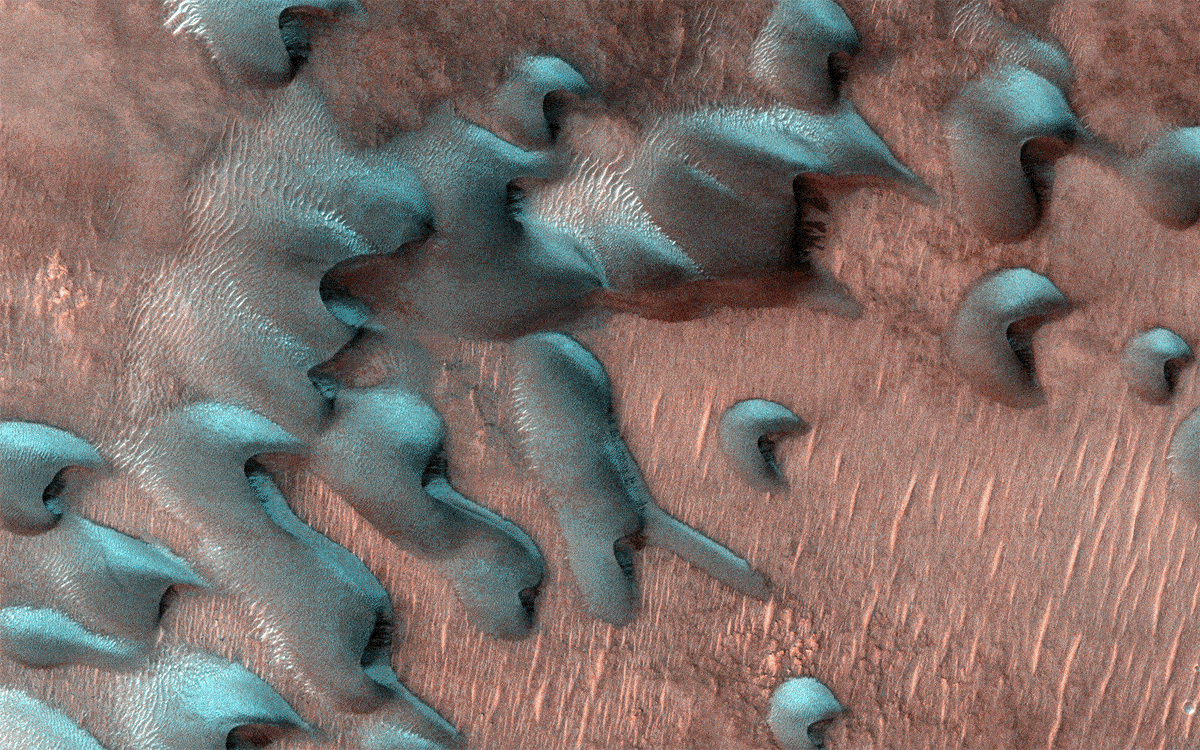Sníh ve tvaru krychle, ledová krajina a mráz, to vše je součástí nejchladnějšího období na Rudé planetě.
Když přijde zima[{“ attribute=““>Mars, the surface is transformed into a truly otherworldly holiday scene. Snow, ice, and frost accompany the season’s sub-zero temperatures. Some of the coldest of these occur at the planet’s poles, where it gets as low as minus 190 degrees Fahrenheit (minus 123 degrees Celsius).

The HiRISE camera aboard NASA’s Mars Reconnaissance Orbiter captured these images of sand dunes covered by frost just after winter solstice. The frost here is a mixture of carbon dioxide (dry) ice and water ice and will disappear in a few months when spring arrives. Credit: NASA/JPL-Caltech/University of Arizona
Cold as it is, don’t expect snow drifts worthy of the Rocky Mountains. No region of Mars gets more than a few feet of snow, most of which falls over extremely flat areas. And the Red Planet’s elliptical orbit means it takes many more months for winter to come around: a single Mars year is around two Earth years.
I na Marsu padá sníh, led a námraza.[{“ attribute=““>NASA’s spacecraft on and orbiting the Red Planet reveal the similarities to and differences from how we experience winter on Earth. Mars scientist Sylvain Piqueux of JPL explains in this video. Credit: NASA/JPL-Caltech
Still, the planet offers unique winter phenomena that scientists have been able to study, thanks to NASA’s robotic Mars explorers. Here are a few of the things they’ve discovered:
Two Kinds of Snow
Martian snow comes in two varieties: water ice and carbon dioxide, or dry ice. Because Martian air is so thin and the temperatures so cold, water-ice snow sublimates, or becomes a gas, before it even touches the ground. Dry-ice snow actually does reach the ground.
“Enough falls that you could snowshoe across it,” said Sylvain Piqueux, a Mars scientist at NASA’s Jet Propulsion Laboratory in Southern California whose research includes a variety of winter phenomena. “If you were looking for skiing, though, you’d have to go into a crater or cliffside, where snow could build up on a sloped surface.”

HiRISE captured these “megadunes,” also called barchans. Carbon dioxide frost and ice have formed over the dunes during the winter; as this starts to sublimate during spring, the darker-colored dune sand is revealed. Credit: NASA/JPL-Caltech/University of Arizona
How We Know It Snows
Snow occurs only at the coldest extremes of Mars: at the poles, under cloud cover, and at night. Cameras on orbiting spacecraft can’t see through those clouds, and surface missions can’t survive in the extreme cold. As a result, no images of falling snow have ever been captured. But scientists know it happens, thanks to a few special science instruments.
NASA’s Mars Reconnaissance Orbiter can peer through cloud cover using its Mars Climate Sounder instrument, which detects light in wavelengths imperceptible to the human eye. That ability has allowed scientists to detect carbon dioxide snow falling to the ground. And in 2008, NASA sent the Phoenix lander within 1,000 miles (about 1,600 kilometers) of Mars’ north pole, where it used a laser instrument to detect water-ice snow falling to the surface.
Vědci z NASA mohou měřit velikost a tvar rozložení sněhových částic vrstvu po vrstvě v bouři. The Global Precipitation Measurement Mission je mezinárodní satelitní projekt, který každé tři hodiny poskytne další generaci pozorování celosvětových dešťů a sněhu. Poděkování: Goddard Space Flight Center NASA/Ryan Fitzgibbons
ledové kostky
Vzhledem k tomu, jak jsou molekuly vody vázány, když zmrznou, mají sněhové vločky na Zemi šest stran. Stejný princip platí pro všechny krystaly: způsob, jakým se atomy samy organizují, určuje tvar krystalu. V případě oxidu uhličitého jsou molekuly v suchém ledu po zmrazení vždy spojeny do čtyř tvarů.
„Protože led s oxidem uhličitým má symetrii čtyři, víme, že suché sněhové vločky budou mít tvar krychle,“ řekl Bicchio. „Díky bezpečnějšímu klimatu na Marsu můžeme říci, že tyto sněhové vločky budou menší než šířka lidského vlasu.“

Kamera HiRISE zachytila tento snímek okraje kráteru uprostřed zimy. Jižně orientovaný svah kráteru, na který dopadá méně slunečního světla, tvoří nerovnoměrnou, jasnou námrazu, která je na tomto snímku ve vylepšených barvách zobrazena modře. Obrazový kredit: NASA/JPL-Caltech/University of Arizona
Jack Frost okusuje váš rover
Voda i oxid uhličitý mohou na Marsu tvořit námrazu a oba druhy námrazy se na planetě objevují šířeji než sníh. Přistávací moduly Viking viděly vodní mráz, když v 70. letech studovaly Mars, zatímco orbiter NASA Odyssey viděl Je pozorována tvorba námrazy, která sublimuje ranní slunce.

HiRISE zachytil tuto jarní scénu, kdy vodní led zamrzlý v půdě rozdělil Zemi na mnohoúhelníky. Průhledný led s oxidem uhličitým umožňuje slunečnímu světlu prosvítat a ohřívat plyny, které prosakují ventilačními otvory, čímž na povrch vystřelují vějíře tmavšího materiálu (na tomto vylepšeném barevném obrázku zobrazeno modře). Obrazový kredit: NASA/JPL-Caltech/University of Arizona
Divný konec zimy
Snad nejúžasnější objev přichází na konci zimy, kdy všechen vytvořený led začíná „tajit“ a sublimovat do atmosféry. Přitom tento led nabývá zvláštních, krásných tvarů, které připomínal vědcům pavouciA Dalmatské skvrnyA Smažené vajíčkaA švýcarský sýr.
Toto „tavení“ také způsobuje erupci gejzírů: průhledný led umožňuje slunečnímu světlu ohřívat plyn pod ním a ten plyn nakonec exploduje a posílá prachové ventilátory na střeše. Vědci již tyto ventilátory začali studovat, aby se o nich dozvěděli více Jakým směrem vanou marťanské větry?.

„Unapologetický analytik. Rozzuřeně skromný kávový evangelista. Hráč. Nelze psát s boxerskými rukavicemi. Student. Podnikatel.“
You may also like
-
Odhalení tajemství struktury mozku u autistických pacientů
-
Kus kovu, který roztrhal dům na Floridě, téměř jistě pocházel z Mezinárodní vesmírné stanice
-
Kosmická srážka, která udělala srdce Pluta
-
Jak zabráníme tomu, aby byla Země spálena intenzivním sluncem?
-
Vědci z University of Utah sbírají vzorky, aby zmapovali šíření údolní horečky prostřednictvím zárodků nečistot

